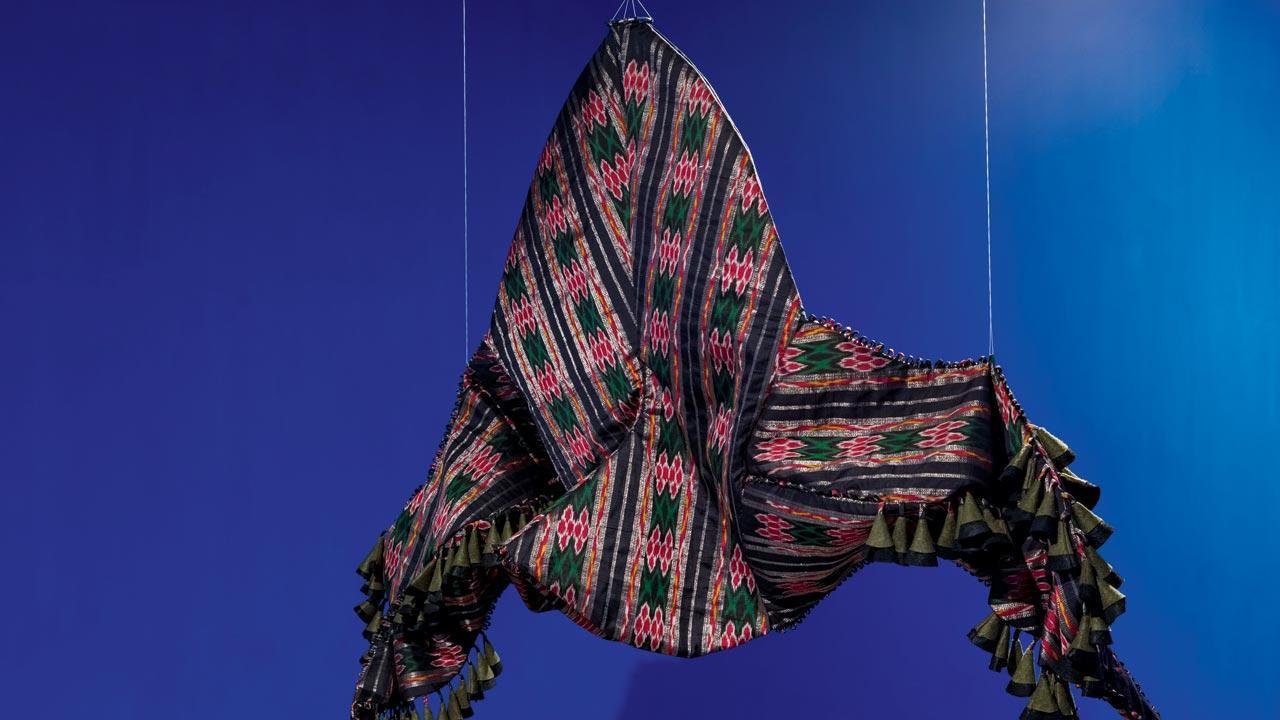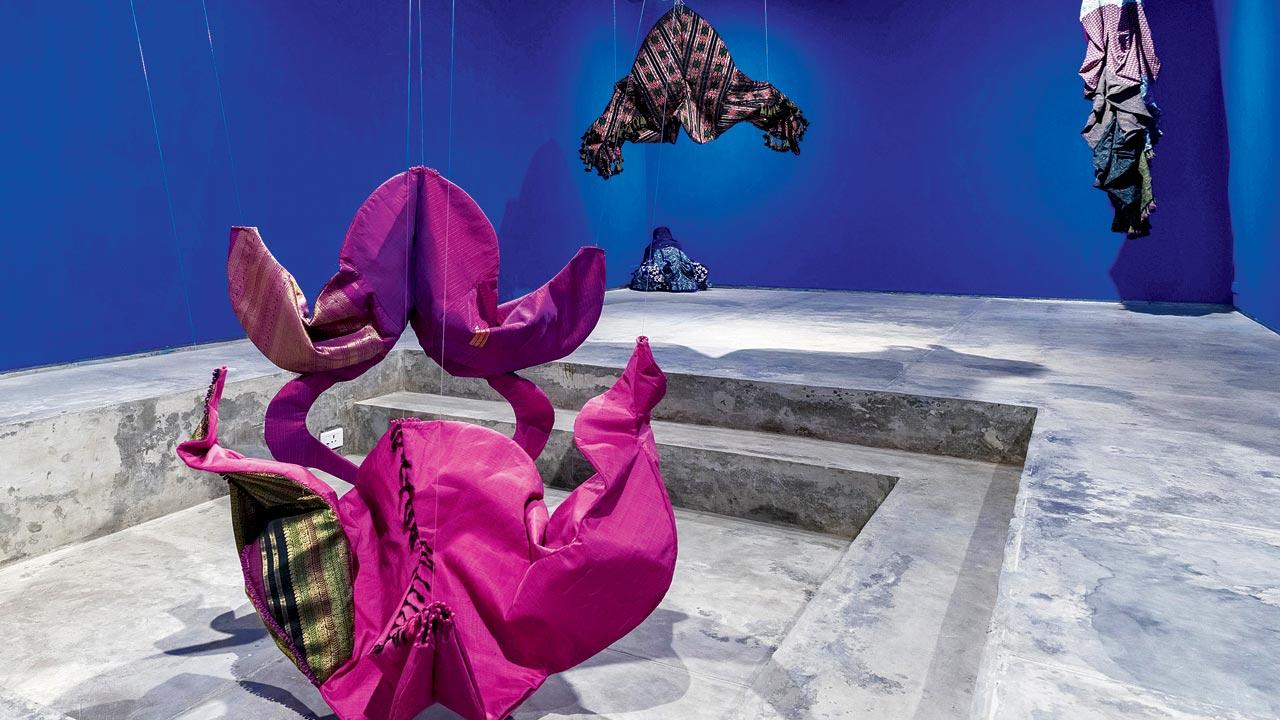Kallol Datta’s upcoming show argues the saree will survive without the rescue hysteria and hopes to push the boundaries of native clothing by questioning material and its apparent utility

The Volume 3 Issue 2 show by Kallol Datta “reproduces” native clothing objects like this Ikat Sambalpuri silk saree donated by a Bengaluru resident who bought it in the 1970s
 Hanging on near-invisible cables, the benign kaftan-like silhouette titled Object 7D, floats meditatively mid-air; its flange hands ending in a cluster of tassels. If this decontextualised “object” resembles a saree, it’s because it is in fact, a pre-owned Kanjeevaram Ikat silk six-yard.
Hanging on near-invisible cables, the benign kaftan-like silhouette titled Object 7D, floats meditatively mid-air; its flange hands ending in a cluster of tassels. If this decontextualised “object” resembles a saree, it’s because it is in fact, a pre-owned Kanjeevaram Ikat silk six-yard.
ADVERTISEMENT
There is a lot happening here because the object probes the viewer although nobody is wearing it. Its creator, Kolkata-based Kallol Datta, explains: “The moment you don’t see it as a utility garment, you need to bring in an emotional connection. So, for me, there’s a grotesqueness in this, vulgarity, and also serene beauty.”
Backed by pattern-cutting tricks and a curatorial strategy, Datta questions the prescribed notions of utility impressed upon the saree, and the social concerns of privilege and gender as a binary. Datta says that he never considers the human form, its gender or sex, while drafting a pattern. “On the flipside, I’m including all genders and sexes [into my thought],” he laughs. What remains then is the pronounced conversation around how certain native clothing practices, like the saree, have been historically used to reframe the notion of cultural sustainability or diversity.
 The show is open for public viewing from July 15 to September 23 in Kolkata
The show is open for public viewing from July 15 to September 23 in Kolkata
The way Datta constructs a narrative around materiality—exalting them as builders of civilisations—clothing becomes an imagined rebel on the fringes, hitting back at the policing of our wardrobes, and shattering tired stereotypes. The addition of tassels, we realise, is deliberate and compels intended distortion. “Clothing is political. We know that aesthetics have played a role in resistance, and that’s why there is the ample use of tassels, cords and loops in this show,” says the finalist of the 2021 Jameel Prize, an international award for contemporary art and design inspired by Islamic tradition.
Starting July 15, visitors to the Experimenter gallery in Kolkata will find this and 15 other native clothing objects audaciously transformed into giant amorphous shapes, for the Volume 3 Issue 2 show. Although he describes himself as a clothes-maker, it’s clear that Datta’s interest lies beyond tangible clothing, say Experimenter’s founders Prateek and Priyanka Raja to mid-day in an email interview. “His work explores the multiplicity of thought on sexuality and gender, organism and form, natural and artificial, sustainability and reuse.”
 Pic courtesy/Rusha Bose
Pic courtesy/Rusha Bose
Still, Datta insists that he has no story to tell. “This is me trying to figure out connections and links between various native clothing tapestries in South-West Asia, North Africa, the Indian subcontinent and the Korean peninsula.” To wit: how a haori from Japan is similar to the Korean hanbok, that’s in turn similar to the angarakha of India and Persia’s manto.
For this project, Datta says he sourced old sarees, either woven or purchased between 1945 and 1989. An online collection drive invited donations of pre-used sarees, an exercise that has helped him know the region of origin and its community better. The donated sarees arrived at Datta’s Kolkata address, often accompanied by letters and family albums. Kanta Jhangiani, a donor from Mumbai, sent an organdy saree and her note said she purchased an organdy saree on the first of every month. She would then get it dyed and hand-block printed. “It became a monthly ritual of sorts until she stopped buying organdy sarees when the mills in Mumbai began to shut down. The donated saree is symbolically linked to her personal history. Even if she is not wearing it, it exists in the folds of time as its own story,” he explains.
He considers the brief time that he thought of himself as a “fashion designer” as one when he churned out “ridiculous amounts of garments” for retail stores. “The fashion industry is its own albatross. We are in the business of mindless production of stuff that ends up in the landfills,” Datta argues, adding that with this project, he has reproduced, not produced. “Newer forms emerged from the donated materials, like the obi, kimono, hakama, all native to Japan, and the sarees from India. The function of ‘clothes’ changes then to not what clothes the body but a keeper of sacred tradition, and anthropological evidence.”
Datta says that the Kanjeevaram Ikat silk saree rechristened Object 7D was donated by Bengaluru-based Surya Kumari Thodla. She bought it from a Sambalpur weaver in the 1970s. With gilded elongated lines in its weft that bloom into a voluminous silhouette, it is an eloquent cultural and social metaphor that does not need a human vessel to justify its lineage. “It’s native to India but also comes with a lot of baggage,” Datta thinks, referring to the unrelenting save-the-saree rhetoric. “We [consumers] give too much importance to ourselves; we think we need to wear it to save it [saree]. Clothes don’t need saving.”
 Subscribe today by clicking the link and stay updated with the latest news!" Click here!
Subscribe today by clicking the link and stay updated with the latest news!" Click here!







